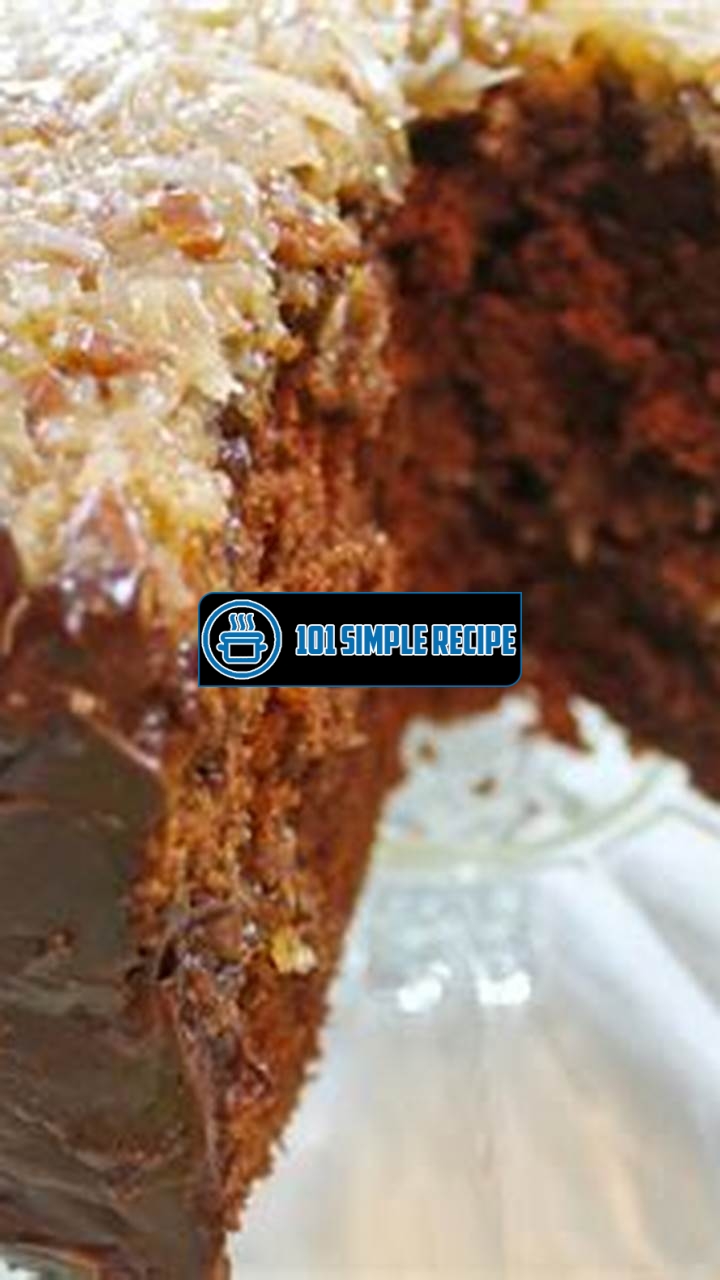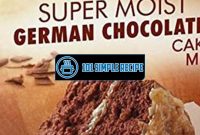Are you ready to indulge in the mouthwatering flavors of homemade German chocolate? Look no further because we’ve got the perfect recipe for you! Whether you have a love for all things chocolate or are simply craving a delightful treat, this homemade German chocolate creation will not disappoint. Picture yourself taking a bite of a rich, moist chocolate cake, layered with a sweet and creamy coconut-pecan frosting. It’s an irresistible combination that will leave you craving for more! So put on your apron, grab your ingredients, and let’s get started on this delectable dessert adventure.

Discovering Homemade German Chocolate
Unveil the rich history and unique flavors of homemade German chocolate, from its origins to modern adaptations.
A Brief History of German Chocolate
German chocolate is a beloved treat that originated in the 19th century in Germany. It was first created by Samuel German, an American who developed a sweet baking chocolate for the Baker’s Chocolate Company in 1852. This chocolate was eventually named “German’s Sweet Chocolate” in honor of its creator.
German chocolate gained popularity and became a staple in American baking. However, it wasn’t until the 1950s that the name “German chocolate” began to refer specifically to the rich and decadent chocolate cake topped with a coconut-pecan frosting that we know today.
The cake gained widespread recognition and became a favorite dessert in households across the United States. Since then, German chocolate cake has become a staple at birthday parties, celebrations, and special occasions.
Main Ingredients and Flavors
The main ingredients of homemade German chocolate are chocolate, sugar, butter, eggs, flour, and buttermilk. The chocolate used is typically a dark or semi-sweet chocolate, which adds a deep and rich flavor to the cake. The sugar adds sweetness, while the butter and eggs contribute to the cake’s moist and tender texture.
One of the defining features of German chocolate cake is its signature coconut-pecan frosting. This frosting is made with shredded coconut, chopped pecans, sugar, butter, and evaporated milk. The combination of these ingredients creates a creamy and nutty frosting that perfectly complements the chocolate cake.
The flavors of homemade German chocolate are a harmonious blend of chocolate, coconut, and pecans. The chocolate provides a strong and bittersweet taste, while the coconut adds a tropical and slightly sweet flavor. The pecans bring a nutty and crunchy texture to the cake, enhancing its overall taste profile.
Popular Variations and Adaptations
Over the years, homemade German chocolate has been adapted and modified to suit different preferences and dietary restrictions. One popular variation is the addition of caramel to the coconut-pecan frosting, creating a luscious and gooey caramel-coconut-pecan topping.
Another adaptation of German chocolate cake is the incorporation of other flavors into the cake batter. Some recipes include ingredients like coffee or liqueur to add depth and complexity to the chocolate flavor.
For those who prefer a smaller portion size, German chocolate cupcakes are a delightful alternative. These individual-sized treats feature all the flavors of traditional German chocolate cake but in a convenient and portable form.
Whether you are a chocolate lover or a fan of coconut and pecans, homemade German chocolate offers a delightful combination of flavors that will satisfy your sweet tooth. The rich history and various adaptations of this classic cake make it a timeless favorite for any occasion.
Indulge in the irresistible flavors of homemade German chocolate and experience the melt-in-your-mouth goodness for yourself!
Benefits of Making Homemade German Chocolate
When it comes to indulging your sweet tooth, nothing beats the rich and decadent taste of homemade German chocolate. Not only does it satisfy your cravings, but it also offers several benefits that make it worth the effort. So why should you consider making your own German chocolate at home? Let’s explore the advantages in detail.
Customization and Personalization
One of the greatest benefits of making homemade German chocolate is the ability to customize and personalize it according to your taste preferences. Unlike store-bought options, you have complete control over the ingredients and can adjust them to suit your liking. Whether you prefer a darker or lighter chocolate flavor, want to add extra nuts or coconut flakes, or experiment with different toppings, the choice is entirely yours.
Tip: Get creative and try adding a dash of cinnamon for a unique twist to your homemade German chocolate.
Healthier Alternatives and Dietary Restrictions
By making your own German chocolate at home, you have the flexibility to choose healthier alternatives for certain ingredients, such as using coconut sugar instead of refined sugar or opting for dairy-free options like almond milk. This allows you to enjoy your favorite treat while adhering to dietary restrictions or personal preferences. Moreover, you have the freedom to control the amount of sugar, ensuring a healthier indulgence.
Pro tip: If you’re looking for a low-sugar option, try substituting some of the sugar with natural sweeteners like stevia or maple syrup.
Saving Money with DIY German Chocolate
Another advantage of making your own German chocolate is the cost savings it offers. Store-bought gourmet chocolates can be quite expensive, especially if you have a penchant for quality. By preparing it yourself, you can save a significant amount of money in the long run. The raw ingredients required for homemade German chocolate, such as cocoa powder, sugar, and coconut, are generally affordable and easily accessible. Plus, you can make a larger batch at a fraction of the cost of store-bought options.
Money-saving tip: Buy the ingredients in bulk and store them properly to maximize your savings on homemade German chocolate.
In conclusion, making homemade German chocolate has numerous benefits. From having the freedom to customize and personalize your treat to catering to dietary restrictions, and even saving money, the advantages are undeniable. So get creative in the kitchen, experiment with flavors, and enjoy the satisfaction of indulging in your very own irresistible homemade German chocolate!
Essential Tools and Ingredients for Homemade German Chocolate
Discover the key tools and ingredients needed to create authentic and delectable German chocolate in your kitchen. Whether you’re a seasoned baker or a novice in the kitchen, having the right equipment and top-quality ingredients is essential to achieve the rich and indulgent flavors that German chocolate is known for.
Must-Have Kitchen Equipment
To embark on your homemade German chocolate journey, there are a few kitchen tools that you must have to ensure success. These tools will not only make the process easier but also help you achieve the desired texture and taste of the final product. Here are the essentials:
- Baking Pans: Invest in sturdy, high-quality baking pans to ensure even heat distribution and prevent your cakes from sticking.
- Mixing Bowls: A set of mixing bowls in various sizes will come in handy for mixing the batter and preparing the frosting.
- Whisk: A whisk is essential for combining ingredients smoothly and incorporating air into the batter for a lighter texture.
- Spatula: A rubber spatula will help you scrape the sides of the bowls and ensure no ingredient goes to waste.
- Cake Stand or Cooling Rack: Once your German chocolate cake is baked, a cake stand or cooling rack will allow it to cool evenly and prevent moisture buildup.
Quality Ingredients and Recipe Substitutions
While having the right tools is crucial, using high-quality ingredients is equally important in achieving the authentic flavors of German chocolate. Here are the key ingredients you’ll need:
- Chocolate: The star of the show, German chocolate typically calls for semi-sweet or dark chocolate. Opt for a reputable brand for the best results.
- Cocoa Powder: Unsweetened cocoa powder adds depth and richness to the chocolate flavor. Choose a high-quality variety.
- Eggs: Eggs provide structure and moisture to the cake batter. Use fresh eggs for the best texture.
- Butter: German chocolate cakes are known for their indulgent, buttery flavor. Be sure to use unsalted butter for better control over the saltiness.
- Buttermilk: Traditional German chocolate cake recipes often call for buttermilk, which adds tanginess and moisture to the cake.
- Pecans and Coconut: These two ingredients are essential for the iconic German chocolate frosting. Look for high-quality pecans and sweetened shredded coconut.
Note: If you have dietary restrictions or prefer alternative ingredients, there are various recipe substitutions available. For example, you can use a dairy-free butter substitute or almond milk instead of buttermilk. Experiment and find the substitutions that work best for you without compromising the overall flavor.
Where to Source German Chocolate Ingredients
Now that you know the essential tools and ingredients for homemade German chocolate, it’s time to find the best sources for these items. Here are a few options:
- Local Grocery Stores: Visit your nearby grocery stores or supermarkets, as they often carry a selection of German chocolate ingredients.
- Specialty Stores: Look for specialty stores that focus on baking supplies or international ingredients. They are more likely to stock authentic German chocolate ingredients.
- Online Retailers: Explore online retailers that specialize in baking supplies or international ingredients. You’ll have access to a wider range of options and the convenience of doorstep delivery.
- Farmers Markets: If you prefer locally sourced ingredients, check out farmers markets in your area. They often have vendors who offer high-quality nuts, chocolate, and other essential items.
By using these sources, you’ll be able to gather all the necessary ingredients to create your own delicious homemade German chocolate.
Now that you’re equipped with the essential tools and know where to source the best ingredients, it’s time to embark on your homemade German chocolate adventure. Get ready to indulge in the rich, irresistible flavors and impress your friends and family with your baking skills!
A Step-by-Step Guide to Making Homemade German Chocolate
Follow a detailed guide to successfully create your own homemade German chocolate, from tempering chocolate to perfecting the coconut-pecan frosting.
Mastering Chocolate Tempering
Mastering the art of chocolate tempering is essential for creating delicious homemade German chocolate. Tempering refers to the process of heating and cooling chocolate to stabilize its crystal structure, resulting in a smooth and glossy finish.
Here’s a step-by-step guide to tempering chocolate:
- Start by chopping the chocolate into small, uniform pieces.
- Melt two-thirds of the chocolate over a double boiler, stirring constantly.
- Once melted, remove the chocolate from heat and add the remaining one-third of chopped chocolate.
- Continue stirring until all the chocolate is melted and smooth.
- Check the temperature of the chocolate using a thermometer. The ideal temperature for dark chocolate is between 88°F and 90°F (31°C and 32°C).
- If the chocolate is too cool, gently reheat it. If it’s too warm, allow it to cool slightly.
- Your chocolate is now tempered and ready to be used for your homemade German chocolate.
Creating the Perfect Coconut-Pecan Frosting
No German chocolate cake is complete without the perfect coconut-pecan frosting. This rich and decadent frosting adds a layer of sweetness and texture to the cake.
Here’s how you can create the perfect coconut-pecan frosting:
- In a medium saucepan, combine evaporated milk, sugar, egg yolks, butter, and vanilla extract.
- Cook over medium heat, stirring constantly, until the mixture thickens. This usually takes about 12-15 minutes.
- Remove the saucepan from heat and stir in shredded coconut and chopped pecans.
- Let the frosting cool completely before using it to frost your German chocolate cake.
- Spread the coconut-pecan frosting evenly over the cake, making sure to cover all sides.
Assembling and Decorating the German Chocolate Cake
Now that you have successfully tempered your chocolate and made the delicious coconut-pecan frosting, it’s time to assemble and decorate your German chocolate cake. This is where your creativity can shine!
Here are some tips for assembling and decorating your German chocolate cake:
- Start by placing the first layer of the cake on a serving plate.
- Spread a generous amount of coconut-pecan frosting on top of the first layer.
- Add the second layer of the cake and repeat the process until all layers are stacked.
- Once the cake is fully stacked, frost the sides and top with the remaining coconut-pecan frosting.
- You can further enhance the cake’s appearance by adding chocolate shavings or sprinkling some shredded coconut on top.
- Get creative with decorations such as edible flowers or chocolate ganache drizzle.
Remember, the key to a beautiful and delicious homemade German chocolate cake is taking your time, following the steps precisely, and allowing your creativity to shine through. Enjoy!
Troubleshooting Tips for Homemade German Chocolate
Making German chocolate at home can be a delightful experience, but it’s not without its challenges. From chocolate seizing to cake collapse, there are common difficulties that many home bakers face. However, with the right knowledge and techniques, these hurdles can be overcome, ensuring a successful outcome that will leave you indulging in irresistible homemade German chocolate. In this article, we will address some of the most common challenges and provide you with tips on how to overcome them.
Dealing with Chocolate Seizing and Separation
One of the most frustrating challenges when making homemade German chocolate is chocolate seizing and separation. This occurs when the chocolate becomes stiff and clumpy, making it difficult to work with. To prevent this issue, it’s important to ensure that no liquid comes into contact with the chocolate while melting it. Even a tiny drop of water can cause the chocolate to seize.
To avoid chocolate seizing:
- Make sure all utensils are dry before melting the chocolate.
- Use low heat and gentle heat sources, such as a double boiler or microwave at a low power setting, to melt the chocolate slowly.
- Stir the chocolate constantly while melting to distribute the heat evenly.
If your chocolate does seize, don’t panic! You can try adding a small amount of vegetable oil or cocoa butter to the mixture and gently heating it to restore its smoothness.
Preventing Cake Collapse and Crumbly Frosting
Another common challenge when making German chocolate cakes at home is cake collapse and crumbly frosting. Cake collapse can happen if the batter is not properly mixed or if the cake is overbaked. Crumbly frosting can occur if the ingredients are not properly measured or if the mixing process is insufficient.
To prevent cake collapse and crumbly frosting:
- Follow the recipe instructions precisely and measure all ingredients accurately.
- Properly mix the cake batter, ensuring that all ingredients are well incorporated.
- Avoid overbaking the cake by setting a timer and regularly checking for doneness using a toothpick or cake tester.
- When making the frosting, make sure to cream the butter and sugar together until light and fluffy. Gradually add the other ingredients to ensure a smooth and cohesive texture.
If your cake collapses or the frosting turns crumbly, don’t despair. You can try salvaging the cake by layering it with stabilized whipped cream or using it as a base for cake pops or crumb toppings. As for the frosting, you can try adding a small amount of milk or cream while remixing it to restore its creaminess.
Rescuing Overbaked or Underbaked German Chocolate Cakes
One final challenge that home bakers face is the dilemma of overbaked or underbaked German chocolate cakes. Overbaked cakes can turn dry and crumbly, while underbaked cakes can be dense and gooey in the center. To rescue these cakes, you can employ a few techniques.
If your cake is overbaked:
- Brush the cake layers with a simple syrup or flavored liquid to add moisture.
- Consider trimming off the hard edges and using a moistening agent, such as a fruit puree or liqueur, to enhance the cake’s moisture and flavor.
- Layer the cake with a filling, such as whipped cream or ganache, to add moisture.
If your cake is underbaked:
- Place the underbaked cake back into the oven for a few more minutes, checking for doneness frequently to avoid overbaking.
- If the cake is too gooey to salvage, you can repurpose it as a trifle or use it as a base for a chocolate bread pudding.
With these troubleshooting tips, you’ll be well-equipped to overcome the common challenges encountered while making homemade German chocolate. Experimenting in the kitchen can be a fun and rewarding experience, and even if things go awry, don’t be afraid to get creative and find alternative ways to enjoy your homemade treats. Happy baking!
Thank you for taking the time to read our article on homemade German chocolate. We hope that you found it informative and inspiring for your next baking adventure. If you’re craving more delicious recipes and helpful tips, be sure to visit our website again later. We regularly update our content to provide you with the latest and greatest in homemade treats. Happy baking!
Frequently Asked Questions
Here are some frequently asked questions about homemade German chocolate:
| No. | Questions | Answers |
|---|---|---|
| 1. | What is German chocolate? | German chocolate is a type of chocolate cake that originated in the United States. It is known for its rich and moist texture, topped with a creamy coconut-pecan frosting. |
| 2. | Can I substitute regular chocolate for German chocolate? | Yes, you can use regular chocolate in place of German chocolate. However, the flavor and texture may be slightly different. |
| 3. | How long does homemade German chocolate cake last? | Homemade German chocolate cake can last up to 3-4 days when stored in an airtight container at room temperature. |
| 4. | Can I freeze homemade German chocolate cake? | Yes, you can freeze homemade German chocolate cake. Wrap it tightly in plastic wrap and place it in an airtight container or freezer bag. It can be frozen for up to 3 months. |
| 5. | What are some variations of German chocolate cake? | Some variations of German chocolate cake include adding additional flavors like coffee or liqueur to the batter, or incorporating different fillings such as raspberry or caramel. |
| 6. | Can I make a vegan version of German chocolate cake? | Yes, you can make a vegan version of German chocolate cake by substituting ingredients like vegan butter, almond milk, and flax eggs. |
Thank You for Reading!
We hope you enjoyed learning about how to make homemade German chocolate. Whether you’re an experienced baker or just starting out, this delicious dessert is sure to impress your family and friends. Don’t forget to visit us again for more mouthwatering recipes and helpful baking tips. Happy cooking!
Jump to Recipe
Homemade German Chocolate

Learn how to make homemade German chocolate cake with this easy recipe. Indulge in the rich and moist chocolate cake layers topped with a creamy coconut-pecan frosting.
- 2 cups all-purpose flour
- 1 3/4 cups granulated sugar
- 3/4 cup unsweetened cocoa powder
- 1 1/2 teaspoons baking powder
- 1 1/2 teaspoons baking soda
- 1 teaspoon salt
- 2 large eggs
- 1 cup buttermilk
- 1/2 cup vegetable oil
- 2 teaspoons vanilla extract
- 1 cup boiling water
- 1 cup sweetened shredded coconut
- 1 cup chopped pecans
- 1/2 cup unsalted butter
- 1 cup evaporated milk
- 1 cup granulated sugar
- 3 large egg yolks
- 1 teaspoon vanilla extract
- Preheat the oven to 350°F (175°C) and grease and flour two 9-inch round cake pans.
- In a large mixing bowl, whisk together the flour, sugar, cocoa powder, baking powder, baking soda, and salt.
- Add the eggs, buttermilk, vegetable oil, and vanilla extract to the dry ingredients and mix until well combined.
- Carefully pour in the boiling water and mix until the batter is smooth. The batter will be thin, but that’s okay.
- Divide the batter equally between the prepared pans and bake for 30-35 minutes, or until a toothpick inserted into the center comes out clean. Remove from the oven and let the cakes cool in the pans for 10 minutes. Then, transfer them to a wire rack to cool completely.
- In a saucepan, combine the shredded coconut, chopped pecans, butter, evaporated milk, sugar, egg yolks, and vanilla extract. Cook over medium heat, stirring constantly, until the mixture thickens and becomes golden brown, about 12-15 minutes. Remove from heat and let it cool to room temperature.
- Once the cakes and frosting have cooled, spread a generous amount of the coconut-pecan frosting on top of one cake layer. Place the second cake layer on top and frost the entire cake with the remaining frosting.
- Slice the homemade German chocolate cake and serve it to your guests. Enjoy!






